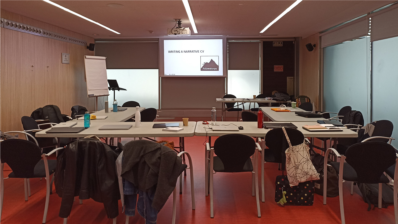Every year, the Open Access Week is celebrated at the end of October.
El·lipse has talked to different stakeholders of the scientific community (researchers, press officers, librarians) about the best way to increase accessibility to research results. From a critical look at the current research publication system, its problems and potential solutions, we focus specifically on preprints – a way of sharing scientific results before their peer review and their official publication in a scientific journal.
The problem
The current academic publishing system has been a focus of heated debate for years, with many within the scientific community highlighting several problems:
- the anonymous peer review
- the misuse of the journal’s Impact Factor
- the economic unfairness of the paywalls behind some journals
- the illogical transfer of copyright from authors to publishers
- the long time it takes (months, if not years), from the moment scientific results are obtained and sent to a journal to the moment they are finally published and made available to the scientific community.
It takes months, if not years, from the moment scientific results are obtained and sent to a journal to the moment they are finally published.
The solution?
Open Access (OA) has arisen as a solution to some of these problems, although it is not the panacea. Since the first Open Access journals appeared, in the late 80’s, the scientific community has slowly but steadily been accepting and using them, but for many the transition to full OA is happening too slowly. Now, the European Commission and a group of national and private funders (such as the Wellcome Trust or Bill and Melinda Gates Foundation), called cOAlition S, have stepped up and proposed a new plan: Plan S.
Plan S is a call for making all research publications free to access by everyone, immediately. Its aim is to finally “make full and immediate Open Access to research publications a reality” from 2021.
“With effect from 2021, all scholarly publications on the results from research (…) must be published in Open Access Journals (…) or made immediately available through Open Access Repositories without embargo.”
Plan S statement
Plan S is ambitious and revolutionary for some, but not everyone sees it the same way. Some worry it will prevent them from publishing in good quality journals and affect their career; others are concerned about the cost. Of course, whether other funders and countries join the S plan effort or not, and the response of the publishers, will affect how successful it is, and what consequences it may bring for researchers.
But in the meantime, some scientists argue that we need to go even further. Michael Eisen, an evolutionary biologists at the University of California, Berkeley, and a leading advocate for open access – as well as co-founder of the Open Access journal Public Library of Science (PLoS) – calls for what he calls Plan U; that funders require not only OA publication, but deposition in preprint servers or platforms before publication.
Beyond OA: preprints
Indeed, preprints are also in the spotlight after many years growing in the shadows. arXiv, the physics preprint, started in the early 90’s and has long been mainstream amongst physicists. bioRxiv, its biology sister, saw the light in 2013 and although it found it harder to take off it currently has more than 1 million preprints downloaded per month. Others followed, like chemRxiv, socArxiv, or the most recent family member, born just this year: medRxiv.
What does the scientific community think about preprints?
We talk to Richard Sever, founder of both bioRxiv and medRxiv, and also to Robert Castelo, a researcher at the Department of Experimental and Health Sciences, Pompeu Fabra University (DCEXS-UPF) and author of one of the first papers to be published in this medical preprint server.
As preprints become more common, other platforms and tools are appearing around them. Prelights, a platform that highlights exciting preprints, is one of them. We took the chance of his visit to the Barcelona Biomedical Research Park (PRBB) to ask Gautam Dey, a postdoc at University College London (UCL) and an active ‘prelighter’, about this new service.
To know what the scientific community has to say, we have asked several PRBB researchers in different fields about their opinions on preprints. Esther Barreiro (researcher at the Hospital del Mar Medical Research Institute (IMIM) and a medical doctor), Iñaki Ruiz-Trillo (researcher at Institute for Evolutionary Biology (IBE: CSIC-UPF), Kristina Haase (researcher at the European Molecular Biology Laboratory – Barcelona (EMBL Barcelona) and Juan Ramon González (statistician at the Barcelona Institute for Global Health (ISGlobal) tell us about their experience and the pros and cons of preprints in their fields.
Finally, we hear a word of caution from the science communication point of view from Omar Jamshed, press officer at the Centre for Genomic Regulation (CRG), and the opinion of the UPF librarian Mar Garreta.
The community speaks
Richard Sever, Assistant Director of Cold Spring Harbor Laboratory Press and Co-Founder of bioRxiv & medRxiv

In which fields people tend to use more preprints, and how has this evolved over time?
Preprints have been used extensively in physics, math and computational science since arXiv launched in the early 90’s. Since 2013 when we launched bioRxiv, biologists have embraced the approach and we’re seeing exponential growth in submissions. Other disciplines are now joining the trend with the launch of chemRxiv, socArxiv, medRxiv, etc. Interestingly, in each case you see specific subdisciplines leading the way; then others follow. For arXiv, it was the high-energy physicists. For bioRxiv, it was genomics, bioinformatics and, more recently, neuroscience that were the early adopters.
Do most preprints end up being published in traditional journals? And what is the view of journals regarding preprints?
Most preprints do end up in traditional journals. bioRxiv finds 70% are formally published after 2 years; arXiv is similar. And 70% is probably an underestimate as papers can take longer than two years to go through peer review, and some papers change title so it’s harder to match preprint to journal article.
“More than 70% of the preprints in bioRxiv are formally published in journals after 2 years; most basic biology journals are happy for authors to post a preprint”
Physics journals have co-existed with arXiv for years. In biology, some journals were wary of preprints, but bioRxiv has changed that. Most basic biology journals are now happy for authors to post a preprint, and >100 journals allow automatics submission directly from bioRxiv. With the launch of medRxiv, we hope the same will be true of clinical journals; some are still cautious but we already see others keen to allow direct submissions from medRxiv.
What type of papers end up in preprints servers?
Most preprints are simply regular articles that end up in journals – so all types of research are represented. But we do have a small number that are Contradictory Results – bioRxiv has a special category for these and there have been some interesting papers that very quickly corrected the scientific record.
What are in your experience the main obstacles for researchers not to post preprints?
I think there are still a large number of researchers who are wary and a bit worried about being scooped if they post a preprint. But when they think more about it they often realize a preprint is an “anti-scooping device” because it allows them to stake a priority claim and control the timing of dissemination themselves.
“Preprinting is actually an “anti-scooping device” because it allows authors to stake a priority claim”
How is medRxiv different than the other preprints?
We always felt that you need to be more careful with medical preprints because there might be more interest from the public and the consequences of posting work that is incorrect are potentially broader than in other disciplines. medRxiv therefore has a number of additional features:
- a more stringent screening process to screen out papers that would be better disseminated only after peer review;
- more prominent labelling that the work is a preprint of research and should not be used to guide clinical practice;
- more extensive declarations by the author about patient consent, IR/ethics approval, competing interests, clinical trial IDs, and appropriate regulatory checklists.
Robert Castelo (researcher at DCEXS-UPF)
“We have posted one of the first manuscripts in medRxiv. It’s important that research becomes available in the public domain, because it is paid with public money”
Esther Barreiro (researcher at IMIM)

Are you familiar with preprints and preprint servers such as bioRxiv and medRxiv?
I am familiar with preprints but I am less familiar with preprint servers such as bioRxiv or medRxvi platform, since Journals usually offer their own preprint server in which the manuscripts can be stored.
Have your ever published a preprint? If so, how was the experience?
I have published only once, quite recently. The experience was excellent. In 24 hours we were told that the preprint version of our manuscript was already stored in their server. Finally, the manuscript was accepted after two rounds of peer-review and it has already been published in the Journal.
Do you read preprints?
So far I have mostly read articles published in journals that are accessible through PubMed. Nonetheless, as preprints become more popular and easily available from the servers, they may be used as another source of information in the biomedical sciences.
Which are for you the benefits and the potential problems of preprints?
Preprints are useful in science as results are published very quickly and they prevent reviewers from feeling tempted to copy ideas or reproduce experiments on the basis of the assigned manuscripts to review. They may also improve the openness and accessibility of the scientific findings.
The potential problems are those derived from the lack of a strict peer-review if scientists start using preprints as their main source of information to conduct their ongoing and future research.
In the specific case of medicine/clinical practice, do you think they can solve problems or rather create new ones? Potential dangers and solutions?
Preprints can certainly mislead clinical practice if used by health-care professionals without any peer-review. As guidelines and statements are the basis of clinical practice at the time of managing and treating the patients, these types of documents must be carefully reviewed by the research councils of the represented societies as well as by expert reviewers in the specific areas. In this regard, preprints may confuse readers and doctors who have to take care of their patients, and thus make serious decisions. The same applies to other sorts of publications such as systematic reviews, meta-analyses, and original research conducted on patients and/or healthy humans. All these sections in a journal must be adequately peer-reviewed before they are made publicly available.
“Preprints can certainly mislead clinical practice if used by health-care professionals without any peer-review”
The solutions in this regard are not simple. In clinical research, only revised manuscripts should be posted in the preprint servers. Unless otherwise indicated, we will continue to get informed by reading articles published in reliable journals in which the peer-review ensures the quality of the contents while vetting the publication of fake studies or misleading guidelines.
Gautam Dey (postdoc at University College of London – UCL) and member of the Prelight community
“Prelights is like a news and views service for preprints: it allows the community to curate what is an exciting piece of research”
Iñaki Ruiz-Trillo (researcher at IBE: CSIC-UPF)

Are you familiar with preprints and preprint servers such as bioRxiv and medRxiv?
Yes. We use bioRxiv sometimes, both to upload manuscripts and to check for new studies. In the fields of evolution, genomics and developmentIt they are becoming more widely used now.
Have you ever published a preprint? If so, how was the experience?
The process was easy, but I still wonder whether this is the way to go. I am not sure how many people use it, whether other researchers will wait for the final manuscript, whether I am wasting people’s time by making them read something that may not be the final paper, etc.
Do you read preprints?
I have read a few. I never browse bioRxiv, but sometimes I get the link from twitter and I may have a look at it. But mostly I prefer to check the final, peer-reviewed version of the paper.
What are the benefits of preprints, in your view, and what the potential problems?
The strongest benefit I see is that papers in bioRxiv can be included in the CV. So, that’s good when applying for grants and when PhDs and postdocs want to apply for a position.
“The strongest benefit I see is that papers in bioRxiv can be included in the CV, which helps when students or postdocs want to apply for a position.
The problem may be that the manuscript is not final. The results will probably be the same once it is published, but how the results are shown, and even some of the interpretations may be different due to the peer-review process and I would prefer that readers have the final, reviewed, improved version. It also creates a problem of timing, on when to publicitize the work: when you send it for preprint or when it is finally accepted in a journal?
Kristina Haase (researcher at EMBL Barcelona)

Are you familiar with preprints and preprint servers such as bioRxiv and medRxiv?
Yes, as far as I know researchers in biology, bio-engineering, and biophysics are using these servers. I personally have read some preprints. I know that they are often modified after considering reviewers comments; however, most of these works are published not long afterwards. I think preprints are usually more relevant if they are about unpublished current research, rather than posting them 1 or more years down the road when they are already also in print.
Have you ever published a preprint? If so, how was the experience?
I have published an article as a pre-print (bioRxiv). This was overall a positive experience, as we had some journal editors directly contact us to ask whether we would consider publishing our article in their journal. Moreover, it is a good way to have the data online prior to some lengthy formal publishing processes.
What are the benefits of preprints, in your view, and what the potential problems?
Preprints are useful tools for quickly disseminating research findings. I think it is a good strategy for getting nearly polished pieces out for view. Of course, these works go out prior to external review, and so we have to consider that some findings may be questioned, or some follow-up studies may be required. Another logistics problem is the fact that some journals will not accept your manuscript if you first submit it to a preprint repository, which is often the case for high impact journals.
Where do you see the scientific publishing system going in the coming years?
Open access journals and articles are becoming more commonly published and referenced. Making articles available to the public and to institutions that cannot afford prohibitive licensing fees is important for disseminating research findings. I think preprint servers are one strategy for making most of this data available to a larger audience.
“Making articles available to the public and to institutions that cannot afford prohibitive licensing fees is important for disseminating research findings”
Juan Ramon González (Associate Research Professor at ISGlobal)

Are you familiar with preprints and preprint servers such as bioRxiv and medRxiv?
Yes, I am. Actually, there are other servers or repositories like Github where people upload R packages to share the first versions of methods before they are uploaded to other repositories like Bioconductor or Neuroconductor. In my group, we also use “figshare” to make scripts and datasets publicly available before the paper is published, just to guarantee reproducible research. Genomics is one of the fields where these types of repositories are most popular!
Have you ever published a preprint? If so, how was the experience?
Yes, I have published several preprints in BioRxiv. It is straightforward and it has allowed us, for instance, to cite this paper in another manuscript, which helps the reviewing process. Also, it is quite useful for PhD students who cannot have the published version of their paper before their thesis defence.
Do you read preprints?
Yes, I read preprints and cite them in my papers. As an example, the last paper I have submitted includes the comparison of the new method we are proposing with an existing one which is only described in BioRxiv (I guess it should be under revision). I guess we do not need other people to evaluate papers at BioRxiv in other traditional journals to see whether it is a good paper or not. As you are reading papers in your field, you can do this yourself and properly evaluate whether the results described in the prepint are of good quality or not.
What are the benefits of preprints, in your view, and what the potential problems?
As I mentioned before, the benefits are related to quickly making publicly available results that may be interesting for other researchers since the reviewing process may last several months. In the case of publishing a new statistical method or bioinformatic tool, as is our case, it may also help to get feedback from people who can use the software during the reviewing process. The potential problems are related to the fact that they cannot be used by people who are not experts in the field since they may not be able to critically read the manuscript and interpret the results. Also, if the papers are read by the media and they think that what is published there is 100% true without a critical review, they may confuse the general population who read these newspapers.
In the specific case of public health, do you think they can solve problems o create them?
In public health I guess it may create more problems than benefits. In my opinion, preprints should be used only for the scientific community. The solution for me is to clearly warn that the information available in the preprints is not the final one and that it requires further evaluation by experts in the field to guarantee a minimum level of credibility.
“In public health I guess it may create more problems than benefits. In my opinion, preprints should be used only for the scientific community”
Omar Jamshed (press officer at CRG)

The press officer at the CRG, Omar Jamshed, has his own view on preprints. Here you can hear him talking about their benefits, but also about some of the challenges and things to keep in mind from a communications point of view, as well as the dangers of the media and the public accessing research that has not been peer reviewed.
“Preprints are here to stay. Researchers are benefiting from them, some journalists are benefiting from them, but is the public really benefiting from them?”
Mar Garreta (librarian at UPF)

What is your opinion, as a librarian, about preprints?
Preprints servers help make dissemination and access to new research much faster and more universal. On the one hand, these platforms are open to the free participation of any researcher. On the other hand, the contents are published in open access and are about a paper that doesn’t houniversally available without any economic or technological barriers.
Initiatives such as Plan U already propose that researchers deposit their papers in preprints servers. The Wellcome Trust (UK) in its Open Access Policy 2021 is positioned in this same direction.
“Preprints servers help make dissemination and access to new research faster and more universal. We will see how the new open peer review initiatives evolve”
The aspects to take into account when publishing preprints are related to the fact that there is no peer review and that can affect quality. From the author’s point of view, some prefer to advertise only their peer-reviewed version as they understand that it is enhanced by the contributions of the reviewers. From the point of view of the reader they must be aware that these preprints have not yet been qualitatively assessed. There are new open peer review initiatives and we must keep an eye on how they evolve.







